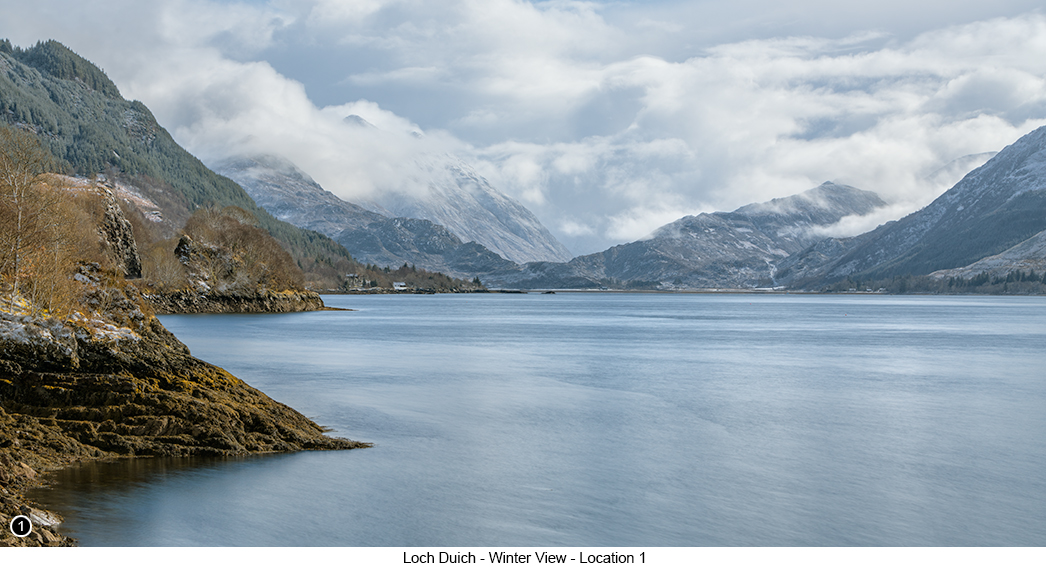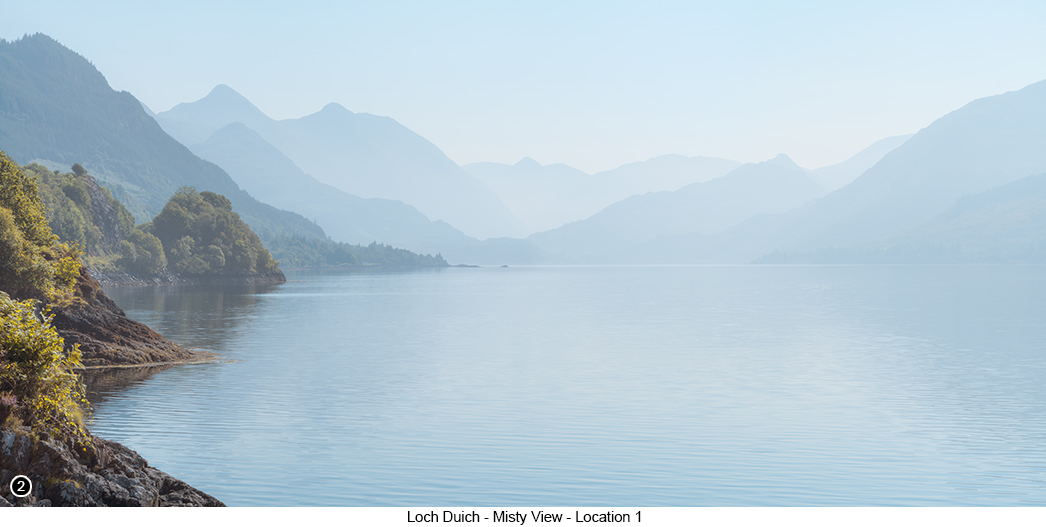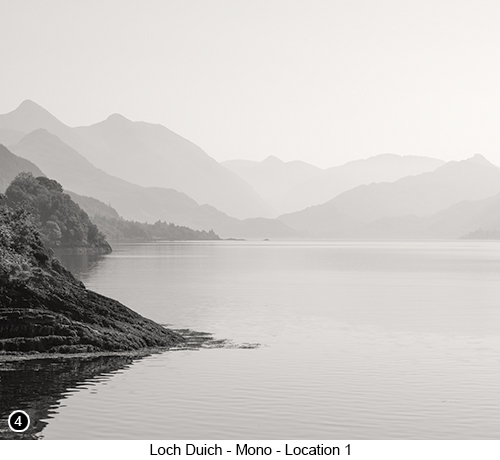

Loch Duich and the Mountains of Glen Sheil |
| Setting the scene: there is an ancient legend associated with the Loch Duich area of Scotland and which refers to the "Selkie", which is said to be a large fur skinned animal that lives in the sea, but who can also walk upon the land if it chooses. The legend also goes on to say, that once the Selkie steps out of the water and onto the land, it is then able to shed its fur skin along with its tail and turn into a beautiful young woman (but now without a stitch of clothing on I presume). Who from the very moment that any man sees her, he will be instantly smitten and fall head over heels in love with her and want to carry her away, to become his wife. But the legend doesn't stop there and goes on to tell a story, about how three young brothers of the Clan MacRae, were out fishing on the banks of Loch Duich one day and how they became transfixed, by the three Selkies they saw rising up out of the loch and then walking up onto the land, to then transform themselves into three beautiful young women. The brothers became instantly and completely besotted with the three young women, even though all three of the brothers were still way too young for wedlock, they still wanted to keep them there on the land. So they rushed over to pick up all three of their discarded furs skins, in an attempt to prevent them from transforming back into Selkies and getting away. However one brother immediately took pity, on the obvious distress being shown by his young female captive, so he gave her back her fur skin, thereby allowing her to return to the sea. The young female captive of the second brother, noticed that he was being temporarily distracted, by what was happening with the first brother, so quickly snatched back her fur skin and jumped back into the loch to escape. But the third brother, seeing everything that was going on around him, decided that he could try to prevent a similar thing happening to him, if he were to set fire to the fur skin he was holding and thereby prevent his captive from returning to the sea. But to his immediate regret, he saw that as soon as he held a flame to the bottom of the fur skin, that it instantly went up in a flash of flames. But that she also burst into flames at the very same moment, burning rapidly within a bright blue column of flame, until there was nothing left, other than a human shaped cloud of smoke, drifting across the surface of the loch. |
|
 |
|
How to get there: This is a very easy location to find, but only once I tell you exactly were it is and describe how to get there. Because other than that, most people and photographers, will simply drive past this viewpoint and not even realise it is there. You see this location is only a couple of miles further South along the shores of Loch Duich, from the world famous and much photographed Eilean Donan Castle. But everyone driving South and away from the castle, will soon arrive at this viewpoint on their right and quickly pass it by. Or even if they do catch a glimpse of it, it will come upon them so quickly after driving round a blind bend, that they will not have enough time to take in what they are seeing, or to slow down and pull into the parking area on their immediate left. I think the main reason why nearly everyone misses this viewpoint, is that it is situated on a very fast part of the A87, which at this point becomes quite narrow and that doesn't seem to have have anywhere easy to park, other than the two places I am going to describe to you now. So most people and photographers, even though they might indeed catch a glimpse of this viewpoint out of the corner of their right eye, will not see the layby passing them by on their left at the very same moment. And even if they do see it, by the time that they do, they have already driven passed it and there is no where to turn round on this very fast road, for several more miles to come. By which time, they will have given up on it and just continue on with their journey, content with their shots of the castle. This means you will very rarely see anyone parked in the places I am about to describe to you, or photographing this scene, even though I hope you will agree after looking these images, this is very much a viewpoint that is well worth photographing. |
|
 |
|
So here is what you need to do to get to and then shoot this amazing view: I will assume you are either coming out of the Eilean Donan Castle car park after shooting the castle, or driving past the castle and heading South. But you need to take your time driving onto the A87 and if at all possible, wait for a large gap in the traffic heading South, so that you have no other traffic behind you. Because if you are in the middle of a line of fast moving traffic, with several vehicles close up behind you, then unless you know exactly where to pull in to the parking area I am about to describe, you are either going to miss it, or end up with a very irate driver behind you and a vehicle climbing up your rear bumper. So after passing or leaving the the Eilean Donan Castle area, you are then going to drive around several fairly tight left and then right hand beds in the road, for the next two miles, until half a dozen bends later, you will see this layby parking area coming up on your left, Street View, Map View. But if you are going to pull in here, you need to be indicating your intentions well before you hit the apex of this last bend, to give the driver behind you, fair warning of what you are about to do. Which is to slow down quite quickly from 60mph and then pull into the layby now on your immediate left. Hence why I suggested above, that the best thing to do, is to wait for a large gap in the traffic, travelling South from the Eilean Donan Castle area, so that you can do this manoeuvre without having to worry, what the driver behind you is going to do the moment you hit your brakes. |
|
So having parked your vehicle safely in the layby on the left of the road, you will see there is a metal Armco barrier on the opposite side, with a thin, flat strip of grass on the other side of the barrier. Walk across the road and step over the barrier. But again you need to be careful here, as vehicles will be coming around the bend to your right at motorway speeds. So wait until you can both see and hear, there is nothing coming. |
 |
So having got yourself across the road safely and using a lens with a focal range of around 200mm (and a 10 stop filter if the loch isn't already fully reflective), then set up your tripod and camera, looking straight down the loch towards the peaks in the distance. With the Five Sisters mountains range on your left and the low lying peaks of Sgurr Mhic Bharraic and Beinn a' Chaioinich on your right, as shown in SHOTS 1 through 4 above. You will also see that there are a couple of small weed covered mounds along the side of the loch, both in front and behind you. Where if you are willing to fight your way through the trouser ripping brambles and scratch your way up to the top, will give you an even clearer view down the centre of the loch. But if you don't fancy ripping your clothing to shreds as I did, then just stay on the thin strip of grass running alongside the barrier and is where I also took a couple of these shots. The only reason I suggest climbing on top of these small mounds, is that you can then set up your tripod, slightly further out into the loch and thereby frame out, more of the roadside rocks in the lower left foreground. Then once you have finished shooting this scene, as a long exposure pano from left to right and with a few single shots etc, then pack up your gear and walk or perhaps drive, to the next one car layby, which is only about 50 yards further down the A87 to your front right, Street View, Map View, but is probably even more difficult to get into. |
|
|
|
You can easily walk down the road to the next location, if you follow the thin grass edge of the road to your right. But again you need to be very aware of fast moving traffic coming towards you, as well as the narrowness of the road at this point - in fact even though this second layby is only 50 yards away from where you are now standing. I would still suggest, that you get back into your vehicle and wait for the road to be completely clear in both directions and then quickly drive over to this second tiny layby and park as far as you can into the back of it. There is only enough room in this second layby for one vehicle, so if it is empty and you are able to drive your vehicle into it, then you are pretty much guaranteed, to have this location all to yourself, as shown in SHOT 5 above and SHOT 6 below. |
|
|
Then once you are safely parked in this second layby, if you look into the trees nearest to the loch on your front right, you will see there is a gap in the trees and an ill defined path down to the edge of the loch. So walk down this path to the shore line and around to the right, for the view shown in SHOT 5 above and SHOT 6 to the right. Tip 1: Best time of year to be here at both of these locations, is in late October or early November for the best autumn colours and especially if we've had some early snow on the peaks. Although winter is also a good time to be here, but the light across the loch in the depths of winter, is quite limited, as the sun soon dips back down behind the mountains on the right side of the loch and throws everything into shadow. Best time of day to be here is around mid to late morning, especially if it happens to be coinciding with a high tide. For the second location, again I suggest you try to be here around mid to late morning, but this time at a three quarter outgoing tide. So if you want to get the best out of both locations on the same visit, try to time it to be here at the highest point of the tide, for the views shown in SHOTS 1 through 4. Then after spending an hour or so working this first part of the scene, the tide will have then receded just far enough, to allow you to easily get down onto the shore, for the second viewpoint. Best conditions to look out for, is obviously a windless day, when the reflections are at their best. But failing that, you could always use your 10 stop ND, to create a long exposure picture, that as 'Gary Gough' refers to it, makes the sea look like an "ice rink". Which is exactly what I did for SHOTS 1 and 3 shown above. |
|
Tip 2: Now unusually for me, this tip has nothing to do with photography, well that is unless you are into wildlife photography, which thinking about it now, is probably most of you. Because even though you will be working only a few feet away from the busy road, for all of the shots shown above, this doesn't seem to bother the local sea life and wildlife, who have obviously got used to the sounds of passing traffic. So you are pretty much guaranteed to see otters fishing and swimming across the loch in front of you, as well as seals and quite a few porpoise. But ideally, you do need the loch to be flat calm and mirror like, to get the best chance of seeing otters. As they always seem to swim, with only the tips of their noses through to their eyebrows, held above water. Which then looks like a small flat surfaced object, moving slowly across the loch. But that only rises above the water, for an inch or so. So even though the otters are always there and probably quite close into shore, if the loch has ripples or waves higher than only a couple of inches, you will find it very, very difficult to see them. Also look out for their bottoms rising into the air as they dive, or a line of bubbles breaking across the surface, as they hunt their prey. I am told by a reliable source (my wife), that otters do not have very good eyesight and rely more on their sense of smell for hunting, so can often come in quite close to you if you remain still. Which is probably what you are going to be doing anyway, especially if you are working from a tripod and shooting long exposures. Because you may be lucky enough to see an otter swimming in very close to you indeed, especially if it catches something big and then drags it up onto the shore to eat it, as they usually do. You are probably not going to believe this, but I once had a large dog otter, walk right over the top of my left boot and then carry on along the shoreline to my left, totally oblivious of me even being there. Although he did stop for a moment after walking over my boot to look back up at me, as he tried to work out what I was. But I assume that because I was standing right next to my tripod, he couldn't make me out as human being shaped object and so decided I wasn't a threat and just carried on with his day. But I have to be honest and tell you, that this wasn't at this location, but back when I was shooting a winter view of Elgol on the Isle of Skye, that I wanted to use for the book. But I have seen otters many times at this location, with the closest getting to within about only 20 feet of me. I am also told by a reliable source (yes you've guessed it), that otters prefer to do most of their fishing during a 3/4 outgoing tide, as this way they will burn up less energy while they are hunting and instead prefer to wait for the tide to bring the fish in towards them as they wait. Yes, clever little blighters aren't they? |
|
Exif information for each of the numbered shots shown throughout this chapter --1 - Canon EF70-200/2.8L IS USM, 10 Sec, f/13, ISO 100, Focal Length 70mm (7 shot vertical pano), taken on 7th Mar at 12:42 --3 - Canon EF70-200/2.8L IS USM, 20 Sec, f/16, ISO 50, Focal Length 95mm, taken on 10th Oct at 13:07 --4 - Canon EF70-200/2.8L IS USM, 1/100 Sec, f/18, ISO 100, Focal Length 73mm (cropped), taken on 11th Feb at 11:42 --5 - Canon EF70-200/2.8L IS USM, 30 Sec, f/13, ISO 200, Focal Length 70mm (9 shot vertical pano), taken on 3rd Nov at 11:03 --6 - Canon EF70-200/2.8L IS USM, 30 Sec, f/11, ISO 100, Focal Length 60mm, taken on 2nd Nov at 10:43 |
|
If you have enjoyed reading these 'Extra' chapters to my Guide Book and think you might also enjoy reading 79 more chapters across 270 pages, that also includes more than 340 Fine Art quality images, along with detailed descriptions and large scale maps to guide you to the exact location of where I took each and every one of them and which then goes onto discuss the techniques and tools I used to process them, but where everything is written in plain easy to understand English? Then please consider buying the Book. |
|